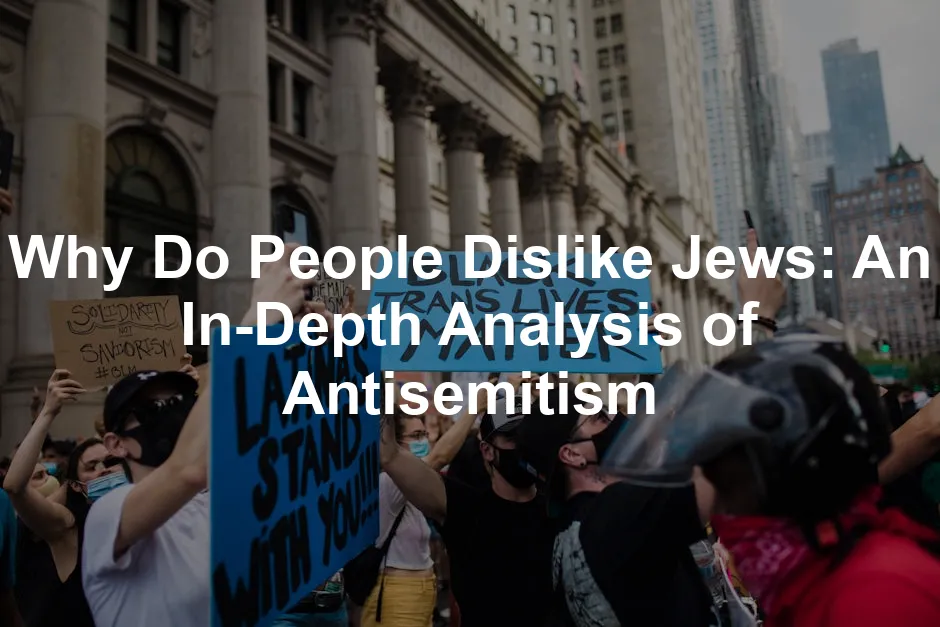
Why Do People Dislike Jews: An In-Depth Analysis of Antisemitism
Introduction
Antisemitism is a long-standing form of prejudice against Jews. It has deep historical roots, tracing back over two thousand years. In recent years, we’ve seen a troubling resurgence of antisemitism worldwide. This article aims to uncover the reasons behind this persistent bias and its impact on society.
To delve deeper into the historical context of antisemitism, consider reading “Antisemitism: Here and Now” by Kenneth L. Marcus. This book offers a timely examination of the issue, making it an essential read for anyone looking to understand the current landscape of antisemitism.
Summary and Overview
Antisemitism refers to hostility, prejudice, or discrimination against Jews. It is a significant societal issue with far-reaching implications. Historically, antisemitism has manifested in various forms, from religious discrimination to racial hatred.
The origins of this animosity often stem from deeply ingrained stereotypes and myths. Understanding these roots is essential in the fight against antisemitism today. As society evolves, so do the expressions of this hatred, adapting to contemporary contexts.
Recognizing the complexities surrounding antisemitism can help individuals and communities combat this age-old prejudice. It is vital to foster dialogue and education to challenge these harmful beliefs.
For a comprehensive look at the historical aspects of antisemitism, you might find “A History of Antisemitism” by Léon Poliakov invaluable. It chronicles the evolution of antisemitic thought and action throughout history.
Historical Context of Antisemitism
Origins of Antisemitism
The history of antisemitism is rich and complex. Early Christian teachings portrayed Jews as responsible for the death of Jesus Christ. This narrative laid the foundation for centuries of discrimination.
Key events, such as the Crusades and the Spanish Inquisition, intensified antisemitic sentiment. During the Crusades, thousands of Jews were murdered as crusaders sought to reclaim the Holy Land. The Inquisition further persecuted Jews, forcing many to convert or face expulsion.
Statistics reveal alarming trends: during the Spanish Inquisition, over 150,000 Jews fled Spain. Pogroms across Europe resulted in countless deaths and widespread suffering. These events highlight the violent history of antisemitism and its devastating effects on Jewish communities.
Understanding these origins is critical for addressing the prejudice that persists today. By acknowledging this dark history, we can work toward a future free from hatred.
To grasp the full scope of these historical contexts, consider reading “The Pity of It All” by Amos Elon, which delves into the history of Jews in Germany, providing essential insights into the dynamics of antisemitism.

Modern Manifestations of Antisemitism
Antisemitism in Contemporary Society
Antisemitism has resurfaced alarmingly in the 21st century. Various factors contribute to this troubling trend. Social media plays a significant role, allowing harmful ideas to spread rapidly.
Platforms like Twitter and Facebook can amplify antisemitic rhetoric. Memes and comments that promote stereotypes gain traction, reaching wider audiences. This environment can distort public perceptions of Jews, framing them as scapegoats for various societal issues.
Political tensions, particularly surrounding the Israeli-Palestinian conflict, also intensify antisemitism. Many people conflate Jewish identity with Israel’s actions. This leads to a perception that all Jews share responsibility for political decisions made by the Israeli government. Such generalizations fuel animosity and hostility toward Jewish communities worldwide.
Recent events have highlighted this connection. Following violent escalations in the Middle East, incidents of antisemitic violence spiked. Jewish institutions faced vandalism, and individuals encountered harassment. These patterns indicate a dangerous intertwining of geopolitical issues and age-old prejudices.
For an in-depth exploration of the modern implications of antisemitism, check out “The New Anti-Semitism” by Phyllis Chesler, which discusses the current crisis and necessary actions to combat it.
Types of Antisemitism Today
Modern antisemitism manifests in various forms, each with unique characteristics. Racial antisemitism views Jews as a distinct race with inherent negative traits. This form often relies on pseudoscientific ideas that paint Jews as inferior.
Political antisemitism focuses on the belief that Jews wield disproportionate influence in politics. This narrative often emerges during economic downturns, as individuals seek scapegoats for their frustrations.
Economic antisemitism portrays Jews as greedy or manipulative. This stereotype has persisted through generations, often resurfacing in times of economic strife.
Cultural antisemitism attacks Jewish culture, accusing Jews of corrupting societal values. Conspiracy theories play a significant role in shaping these beliefs. Many conspiracy theories falsely suggest that Jews control global institutions such as banks and media.
Statistics reveal a troubling trend: hate crimes against Jews have risen significantly in recent years. In 2022, the FBI reported a sharp increase in antisemitic incidents, accounting for nearly 60% of religious-based hate crimes in the United States. This alarming rise underscores the urgent need for awareness and action against all forms of antisemitism.
Combating these diverse manifestations of antisemitism requires collective effort. Education and open dialogue can challenge stereotypes and foster understanding. By recognizing the complexities of antisemitism today, society can work toward a future free from hatred and prejudice.

Psychological and Social Factors
Psychological Underpinnings of Hatred
Understanding why some people harbor antisemitic beliefs can be complex. Psychological theories suggest that hatred often stems from deep-seated insecurities. Individuals might project their fears onto others, blaming them for societal problems. This scapegoating allows people to avoid confronting their own issues.
Scapegoating has historical roots. Throughout history, Jews have often been unfairly blamed for societal problems, from plagues to economic downturns. This pattern creates a convenient target for frustration and anger. When things go wrong, it’s easier to blame a minority group rather than addressing systemic issues. This dynamic can lead to a cycle of hatred that perpetuates itself across generations.
For an insightful exploration of the psychological aspects behind these beliefs, consider reading “The Dangers of a Shallow Faith” by David A. Heller, which discusses the importance of depth in belief systems and its implications.
Societal Influences
Societal influences significantly shape attitudes towards Jews. Education plays a crucial role in combating or fostering antisemitism. When schools teach about diversity and acceptance, they can reduce prejudice. Conversely, a lack of education can lead to ignorance and fear of the unknown.
Cultural narratives also impact perceptions. Many societies have narratives that portray Jews negatively, often based on stereotypes. These narratives can become embedded in popular culture, influencing public opinion. Social structures, including group dynamics, contribute to prejudice too. People may adopt antisemitic views to fit in with their peers or community.
Moreover, the internet and social media amplify these messages. Online platforms can serve as echo chambers, reinforcing harmful beliefs. When individuals are surrounded by like-minded people, they are less likely to question their beliefs. This environment can escalate antisemitism, making it more pervasive and harder to combat.

The Consequences of Antisemitism
Impact on Jewish Communities
Antisemitism has profound social, cultural, and economic effects on Jewish communities. Discrimination can lead to isolation, impacting mental health and community cohesion. Members of these communities often feel marginalized and vulnerable.
Personal stories highlight this emotional toll. Many Jews report experiencing fear and anxiety in their daily lives, especially in public spaces. This constant stress can lead to long-term psychological issues, affecting their overall well-being.
Economically, antisemitism can limit opportunities. Discrimination in hiring practices or workplace environments creates barriers to success. This not only harms individuals but also impacts the broader community.
Antisemitism’s consequences extend beyond Jewish communities. It erodes societal cohesion, fostering division and mistrust. If left unaddressed, these issues threaten the stability of democratic values and social harmony. Thus, recognizing and addressing antisemitism is vital for a healthy society.
To understand the broader context of these consequences, consider reading “The Origins of Totalitarianism” by Hannah Arendt. It provides insights into how societal structures can contribute to prejudice and discrimination.

Broader Societal Consequences
Antisemitism erodes societal cohesion. When a group is targeted, it creates division. This discord undermines democratic values, making it harder to unite for common goals. Communities become fractured when prejudice takes root. When one group suffers, all of society feels the strain.
If antisemitism remains unchecked, future generations may inherit a divided world. The normalization of hate can lead to increased violence. It can also foster an environment where discrimination becomes commonplace. This cycle of hatred threatens not just Jewish communities but the core of democratic principles. Our collective future relies on addressing this issue now.
Combating Antisemitism
Education and Awareness
Education is key to fighting antisemitism. Awareness programs can help dismantle stereotypes and foster understanding. Schools and communities must prioritize teaching about the dangers of hate. Initiatives like Holocaust education are vital in shaping young minds.
Many organizations offer resources to promote tolerance. For example, interactive workshops encourage dialogue between diverse groups. These initiatives can break down barriers and encourage empathy. By equipping individuals with knowledge, we can confront ignorance head-on.

For a deeper understanding of the Holocaust and its implications, you can explore “The Holocaust: A New History” by Laurence Rees. This book provides a thorough account of the Holocaust and its lasting impact on society.
Legal and Political Measures
Governments play a crucial role in combating antisemitism. Existing laws protect Jewish communities from discrimination and hate crimes. These laws must be enforced to ensure safety and justice.
Organizations also contribute by advocating for policy changes. They work to raise awareness of antisemitic incidents. A united front against hate sends a powerful message. When governments and communities collaborate, they can create a safer environment for all.
In conclusion, the fight against antisemitism requires action on multiple fronts. By investing in education and enforcing protective laws, we can build a more inclusive society. Together, we can combat hate and foster understanding.

Conclusion
Antisemitism is a complex issue with deep historical roots. We explored its origins, modern manifestations, and psychological factors that fuel this prejudice. Understanding the reasons behind antisemitism is essential. This knowledge helps us recognize its harmful impact on individuals and society.
Combatting antisemitism requires collective action. We must engage in open dialogue, promote education, and foster tolerance. Each of us can play a part in creating a more inclusive environment. Let’s work together to challenge stereotypes and reject hatred in all its forms. Join local initiatives, support educational programs, and share this article to spread awareness. Together, we can combat antisemitism and build a more tolerant world.
FAQs
What is antisemitism?
Antisemitism, or Jew-hatred, refers to hostility, prejudice, or discrimination against Jews. It can manifest in various forms, including social, political, and economic discrimination.
Why do some people feel antisemitic sentiments?
Antisemitic sentiments often stem from psychological insecurities and societal influences. Scapegoating is a common factor, where individuals blame Jews for broader societal issues.
How has antisemitism evolved over time?
Antisemitism has changed from religious discrimination to racial and political expressions. Historical events like the Holocaust shaped modern attitudes and beliefs.
What can individuals do to combat antisemitism?
Individuals can promote tolerance by educating themselves and others. Supporting local initiatives, participating in discussions, and challenging antisemitic remarks are vital steps.
Are there laws against antisemitism?
Many countries have laws prohibiting hate speech and discrimination. These laws aim to protect Jewish communities and promote social harmony.
Please let us know what you think about our content by leaving a comment down below!
Thank you for reading till here 🙂
Understanding the reasons behind prejudice can be linked to various factors, including pain tolerance. For more insight, check out Why do some people have a higher pain tolerance than others.
All images from Pexels




